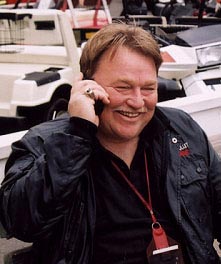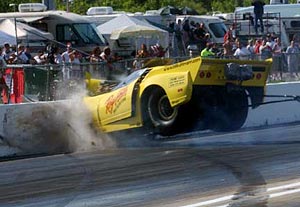|


7/2/03
How safe is safe enough?

 f there is one thread in drag racing
that has remained unbroken throughout the sport's 50 year
or so history, that thread is the safety of the racer. When
Wally Parks gave birth to the NHRA, safety was the midwife.
To this day the safety of the racer and spectator at the drags
is paramount in both the NHRA and IHRA and to a lesser degree
at the smaller sanctioning bodies. If there is a problem with
maintaining a high standard of safety, it is the same one
that prevents some racers from going fast. I guess that the
old adage that you can go as fast as your wallet will let
you applies to safety too. Safety, like speed, always comes
at a price, but the price paid for not having safe racecars
or tracks can be much higher than anyone wants. Sometimes
racers and fans pay with their lives.
f there is one thread in drag racing
that has remained unbroken throughout the sport's 50 year
or so history, that thread is the safety of the racer. When
Wally Parks gave birth to the NHRA, safety was the midwife.
To this day the safety of the racer and spectator at the drags
is paramount in both the NHRA and IHRA and to a lesser degree
at the smaller sanctioning bodies. If there is a problem with
maintaining a high standard of safety, it is the same one
that prevents some racers from going fast. I guess that the
old adage that you can go as fast as your wallet will let
you applies to safety too. Safety, like speed, always comes
at a price, but the price paid for not having safe racecars
or tracks can be much higher than anyone wants. Sometimes
racers and fans pay with their lives.
What has me up on the tires about safety is a series of
events that have occurred over the past three weeks or so.
The first was the problem with NHRA's track at the recent
Columbus race and IHRA's track at their season opener at
Rockingham. At both tracks it was obvious that there was
a problem with traction. In both cases the sanctioning body
allowed the racers to race despite the obvious problems
and only threw in the proverbial towel after several cars
crashed, destroying several hundred thousand dollars worth
of race cars, and scaring the crap out of the drivers and
fans.
No doubt the thought of calling a race for a day, refunding money, postponing the event or a combination of all three tempered their judgment in determining what action to take. That is understandable from a business point of view, but hard to justify to the racer with a destroyed car or a family member who just watched the dad, husband, or son crash.
In both cases the tracks and sanctioning bodies eventually
made the correct decision. They stopped the race in Columbus
and re-prepped the track, and actually changed the rear-spoiler
rules on the spot. At Rockingham they postponed the event
and owner Steve Earwood is completely repaving his facility
to fix the problem.
The events at those two races perturbed me a little but I don't hold the sanctioning bodies or track owners responsible for what happened at those events. If racers race on tracks they know before hand might not be safe then they accept the risk and the blame. The sanctioning body should furnish as safe a track as they can, but the ultimate decision to race rests with the individual driver and no one else.
Having said that, I do have a problem when the sanctioning bodies turn a blind eye to obvious safety issues, or allow racers, manufacturers, or history to dictate policy.
Let me give you a couple of examples. A couple of years
ago IHRA tech officials gave way to pressure from Pro Mod
racers using nitrous oxide injected engines and raised the
minimum weight of supercharged Pro Modifieds to 2600 lbs
and then 2700,lbs in a fruitless attempt to "level the playing"
field between the two types of Pro Mods.

Photo by Dave Kommel / Autoimagery |
Supercharged Pro Mods generally come to the starting line
about 70-80 lbs over minimum weight with a full tank of
fuel. At the time those rules were instituted, many struts
were rated for use with vehicles weighing 2600 lbs or less.
Since that time the strut manufacturers have beefed up their
products to accept the additional weight. When IHRA raised
the minimum weight for supercharged cars to 2700 lbs last
year, some of those racers began to experience wheel failure.
Among those who had wheel failure were Johnny Rocca, Troy
Critchley, Fred Hahn and, most recently, Bill Kuhlmann.
Wheel manufacturers have implemented some measures since
the first failure, yet these 2700-lb cars continue to stress
the wheels and fail as a result.
Then there are the Stock and Super Stock classes where they have cars that run near the sevens! I grant you that there is only one seven-second car but there are plenty of eight-, nine- and ten-second cars in those classes. At the St. Louis NHRA event, after watching Bill Kuhlmann drive into a concrete wall at an estimated 125-plus mph in a 2700-plus pound car, I saw something that just made the hair on the back of my neck stand up. Multi-time World Champ Jeg Coughlin Jr got into his eight-second, 140-mph Super Stocker without a firesuit and gloves. I'm not positive but I don't think he was wearing a neck brace under his helmet, either. Then I watched Dan Fletcher get into his ten-second '69 Camaro Stock Eliminator car wearing no gloves, sweatpants, a cotton shirt, tennis shoes, no socks and an open-face helmet.
What if either one of these guys had broken an axle, had a flat tire, or something else that drove their car into the concrete wall at St. Louis at over 100 mph. I don't want to think about what could result.
I know that NHRA and IHRA have their hands full with so many classes, racers, and races, trying to keep all the racers and fans safe. But regardless of that problem, whether the racers are in an exhibition class or a pseudo-sportsman class, I'm begging you all to be more pro-active in safety decisions. I don't care if Stock/Super Stock racers don't want to spend the money for real safety equipment. I don't care if Pro Mod is just an "exhibition" class.
It's time for those that are in charge to step up and save these guys from themselves before we all have to attend someone's funeral. I'm begging you. Please!!! 
|